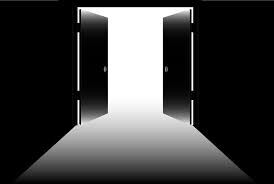Anxiety
3 Doorways to Healing Anxiety
“Deconstructing" anxiety in mind, body, and spirit.
Posted April 14, 2021 Reviewed by Jessica Schrader

“Come to the cliff, he said. We are afraid, they said. Come to the cliff, he said. They came. He pushed them. And they flew.” —Stuart Wilde
In the “Deconstructing Anxiety” model, it is posited that a single “core fear” underlies every problem we experience. The great key to resolving anxiety is to look at and, as necessary, directly face this core fear. In this post, we will describe the three “doorways” that can be opened with that key, the doorways of the mind, the body, and the spirit.1
Opening the doorway of the mind means getting a deep insight into a problem and discovering it is not “real” in the sense we usually think of it. At most, we find a manageable problem. Most often, we find there was no actual problem at all, only the residue of childhood assumptions never questioned.2 Opening the doorway of the body means taking a physical action to literally move through one’s fear, giving the direct experience that the problem we were afraid of cannot carry out its threat. And opening the doorway of the spirit means getting so filled up with a “higher” perspective that the fear loses its power, appearing insignificant in comparison.
A Holistic Approach
This is one of the fundamental descriptors of what is called holistic or transpersonal psychotherapy. The three doorways represent the whole that we are—mind, body, and spirit. It is impossible to address one part of who we are without addressing the other two; as in systems theory, when one part is affected, the other two are as well. Therefore, if we are to fully resolve anxiety, if we are to achieve true freedom, we must do so in mind, body, and spirit. All three doorways are inextricably linked and must be recognized as such in our search for a cure for what ails us.
To elaborate: In entering the doorway of the mind, we seek a true insight into the source of our anxiety. Once found, this insight shows the anxiety to be “illusory,” as above. If we have really seen this, then we spontaneously feel “bigger” than the fear and experience an expansion of the spirit. At the same time, the physical tension in the muscles release spontaneously and we realize a deep and profound relaxation. If, on the other hand, someone starts by walking through the doorway of the body, using, for instance, an abreactive approach such as in Gestalt therapy (pounding, screaming, or otherwise squeezing out the physical tension on a pillow), we may know they are not finished until they have a concomitant release of fear in the mind and expansion of the spirit. And if someone resolves their fear by getting filled with a higher, “spiritual” perspective, seeing the fear as inconsequential in comparison, then it must necessarily dry up in their thoughts and melt out of their body as well, if the resolution of anxiety is to be complete.
Advantages of This Model
Again, it is not only necessary but, in the end, unavoidable that we address all three doorways if we are to heal from anxiety and discover our fulfillment. Furthermore, this holistic model provides an essential flexibility in our approach that can save enormous amounts of time. We no longer have to work out problems that arise in the mind, body, and spirit separately. Working through the problem at the root in one of the doorways spontaneously resolves it in the other two. Because these three doorways are so thoroughly interconnected, it is not necessary to spend years in meditation, work out all holding patterns in the body, or resolve all neuroses in the mind. Approaching each of these separately, and without getting at the root of the true problem, will only resolve some of our problems, while others will remain to keep us bound to anxious thoughts, physical tensions, or spiritual limitations.
In this way, our holistic model also becomes our trusted compass. It can be used to assess whether we have, in fact, faced the right fear at the root of the problem. If not, problems will persist or resurface. And it can be used to measure whether our fear is truly and fully resolved. We simply check whether the fear is released in each of the three doorways: Do we have a true insight that the fear isn’t “real,” a deep relaxation in the body, and a spiritual sense of new possibilities no longer hampered by fear?
It can sometimes be much easier to address our fear by opening one doorway instead of another. The flexibility of our approach lets us choose which doorway is most accessible to us in a particular situation. For example, someone who has obsessive thoughts may do well to avoid the doorway of the mind if it were to encourage further obsession. For another, the same doorway might be the best way to discover the fear at the root, with an insight that clears up confusion and shows their fear to be unreal. Someone who is filled with anger may need to discharge that energy physically first by walking through the Doorway of the Body. And someone who is depressed from an existential despair or struggling with a sense of meaninglessness might well find the doorway of the spirit to be most effective.
In future posts, we will begin elaborating on some of the various exercises in the Deconstructing Anxiety model that enter these three doorways, in the pursuit of a true resolution of anxiety and an enduring fulfillment.
References
1 The word “spirituality” can evoke much resistance in our society, but this is easily taken care of. Here is a workable definition: Spirituality is that which transcends the limits of our usual, empirically based understanding of who we are and what reality is in a way that coheres (i.e., is not psychotic or psychologically disorganized) and is fully integrated (i.e., all parts of the understanding relate to each other in a logically consistent way), giving a sense of purpose and meaning to existence. This is no more mysterious than the phenomenon of thinking ... we cannot use our five senses to know that we have thoughts, and yet no one would deny we do!
2 A recent study showed that 91.6% of the things people with generalized anxiety disorder worry about never come true, and the other 8.4% of problems turn out to be more ordinary and less problematic than originally imagined.
Pressman, T. (2019). Deconstructing Anxiety: The Journey from Fear to Fulfillment. Lanham, MD: Rowman and Littlefield.


